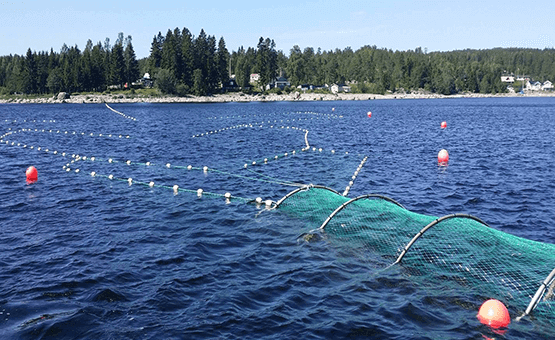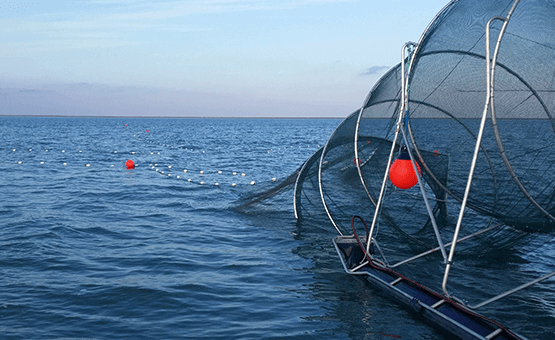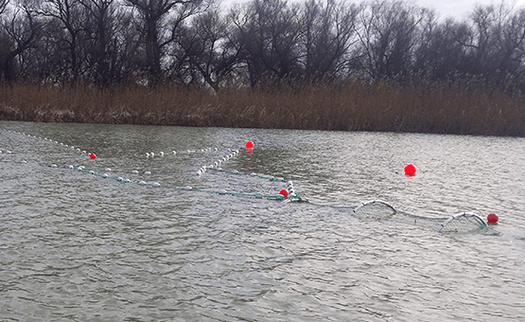



The trap comprises a number of parts. The lead net is a long straight net that guides the fish into the wings where the fish sometimes swim for a period before entering the second adapter and the adapter. The openings gradually become narrower and narrower and the fish are guided on into the fish chamber. The first entrance to the fish chamber is equipped with a seal exclusion device (SED) that effectively stops seals from reaching the catch. The fish pass through the SED and swim on through the final opening. Finally, the fish find themselves caught between an arrangement of nylon threads set at narrow intervals under tension at the far end of the fish chamber. The purpose of the nylon threads is to make it difficult for the fish to find their way back out of the fish chamber.
The lead net and wings are made of polyethylene netting. The second adapter and the adapter, which are more frequently attacked by seals, are made from stronger materials (Polyethylene Premium Plus and Dyneema). The trap is manufactured in such a way that sharp angles and tight corners are avoided. Tight corners can otherwise be used by the seals as hunting spots, into which they can corral the fish before eating them.
We use the highest quality rope, leaded rope and floats in our nets.
The salmon/whitefish trap is our largest model and comprises four parts. The lead net is often 100-240 m long, and the wings are normally 50 m long. These parts are made from polyethylene. The next sections (the second adapter and adapter) are made from stronger netting that can withstand seal attacks: Premium Plus and Dyneema®.
The standard depth for the lead net and wings for salmon is 8.5 m, but it is not uncommon for these parts to be bottom-set to better catch whitefish at depths of 12-15 m.
The herring/vendace trap tends to be slightly smaller than the salmon trap and comprises three parts. The lead net is often approx. 100-150 metres and the wings measure approx. 30 metres. A common material used is knotless nylon with a mesh size of 12 mm.
Wings are bottom-set and these traps are normally used at depths ranging from approx. 6 to 15 metres.
The perch/pike-perch/cod traps are our smallest traps and can have a lead net of just 20 m. However, the most common lengths are 60-100 m. The wings for shallow depths (3-4 m) are a maximum of approx. 14 m in length.
For greater depths (5-8 m), the length of the wings can be increased. For cod, it is common for wings and the second adapter to be covered with a roof and to be set deeper.
We have been commissioned by various municipalities and fishing associations to manufacture traps to capture brood fish. These traps are used in flowing water and are usually only about one metre high.
They are used to capture primarily trout with roe and soft roe for transfer to a hatchery.

EUROPEAN UNION
European Fisheries Fund
An investment in sustainable fishing